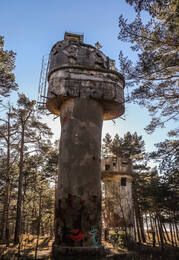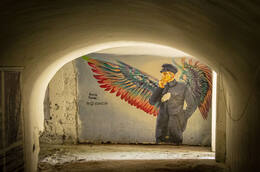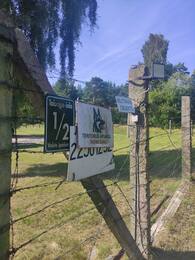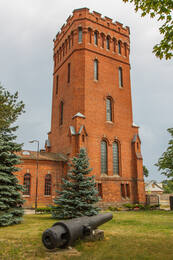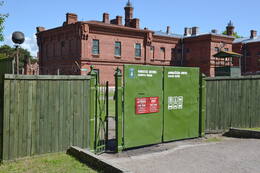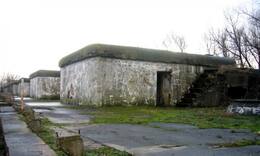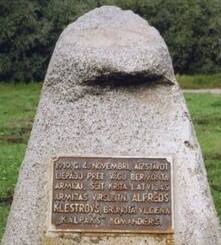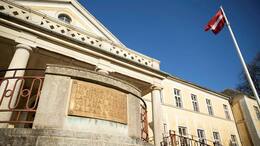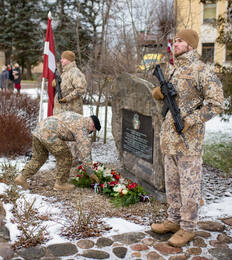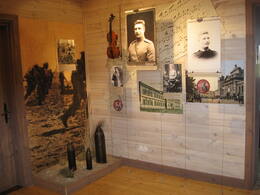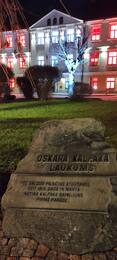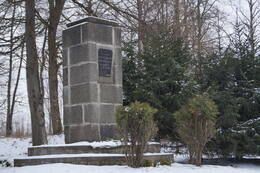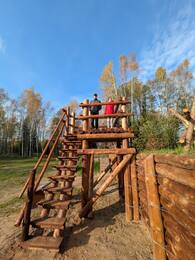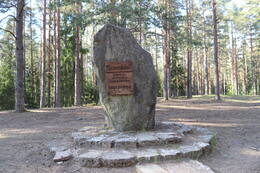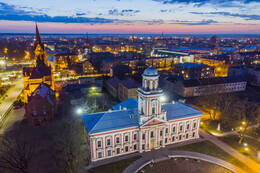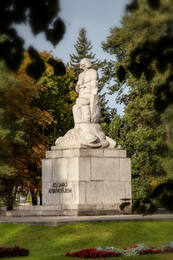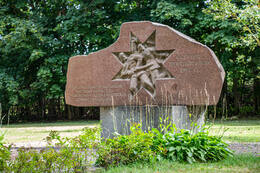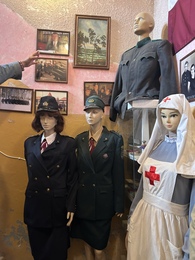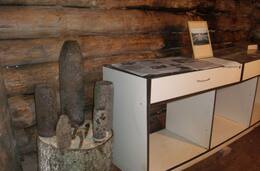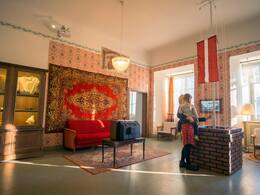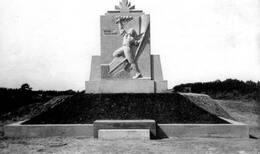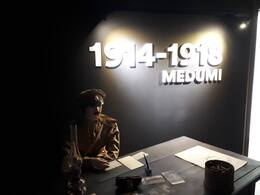World War I and the Wars of Independence in Southern Latvia
Karosta, the Military port of Liepāja (tour)
The Karosta is the largest historical military territory in the Baltics and occupies almost one third of the entire territory of Liepāja. The Karosta is a unique compound of military and fortification buildings on the shores of the Baltic Sea with a special meaning in the history and architecture of Latvia and the world. The Karosta features such military heritage sites as the North Pier and forts, the Redan, Karosta Prison, Karosta Water Tower, St. Nicholas Orthodox Maritime Cathedral, Oskars Kalpaks Bridge and others.
The Redan, Karosta
Redans, or Redana Fort, is located in Karosta, 14. novembra Street, about 1.5 km from the Northern Forts, in the nature reserve "Tosmare".
Historically, redans were elements of fortifications where longer sections of fortress walls were divided into shorter sections by building V-shaped positions facing the enemy, which allowed for better protection of the fortification wall. Karostas Redan is a late 19th century Liepaja Sea Fortress, projecting towards Lake Tosmare. As the fortress lost its fortress role, the fortifications and forts around it were partially blown up and rendered unusable. However, Redan remained almost intact.
In November 1919, after the failure at Riga, Pavel-Bermont Avalov's forces launched an intensive attack on Liepaja. The battle was also fought at Redan, where 80 soldiers of the Liepaja Military Port Commandant's Office under the command of Lieutenant Commander Radzins fought. In a swift attack on 14 November, the Bermontians managed to take Redan. This was followed by a counter-attack by Latvian troops and Redan was retaken.
In June, July and August, a knowledgeable guide will be waiting at Redan every day from 11.00-17.00, ready to tell you more about Liepāja Fortress and the historical events in the Karosta.
Liepāja Coastal Artillery Battery No. 2
Among the many objects of the Liepāja Naval Museum, the Liepāja Coastal Artillery Battery No. 2 is still the most mysterious place in Liepāja. Battery No. 2 was invariably equipped with ammunition depots for the troops of various existing powers.
Liepāja Fortress Battery No. 2 was built further from the coastline and was protected by a high fortification wall. The battery was armed with 16 11-inch (280 mm) mortars of the 1877 model. After the fortress was dismantled, ammunition depots were set up here. Due to the explosive hazard, the territory was closed to the public for 130 years, a guarded area, but now an exhibition has been set up here about the activities of the 1st Courland Division Headquarters in 1919-1940, as well as photographic evidence of the 1st Liepāja Infantry Regiment, the 2nd Ventspils Infantry Regiment and the Courland Artillery Regiment.
Karosta Water Tower
The water tower is located in Liepaja, in the Karosta, at 29 General Baloža Street - where the street meets Lazaretes Street. The water tower was an important building in the Karosta, as it supplied almost the entire Karosta area with drinking water. The exact time of construction of the water tower is unknown, but it could have been between 1903 and 1905. The project was probably designed by the St Petersburg architect Stefan Galenzovsky.
The water tower was powered by a steam engine with two coal boilers, one of which was kept in reserve, so there is an equally tall chimney next to the tower. The transmission powered four pumps, two of which were kept in reserve. Four boreholes supplied water to the pumps, which pumped it to a reservoir on the fifth floor of the tower and from there to the officers' apartments and soldiers' barracks in the Karosta.
When the Latvian Army took over the management of the water tower, the Ministry of War also took over the management of the water tower. After the Second World War, the Soviet Army took over the management. The water tower has been closed since 1989.
Although the tower was not a military building, in November 1919 the Latvian Army corrected the artillery fire of the British warships in the fight against the attack of the Bermont troops.
https://industrialheritage.travel/lv/objects/karostas-udenstornis/51
Liepaja Fortress Battery No 6
The 6th Battery, which is the best preserved fortification structure today, was planned to protect the coast of Liepaja Fortress south of the Trade Canal. The battery was to house four 6-inch (152 mm) guns of the 1892 model of the Canet system, eight 11-inch (280 mm) guns of the 1887 model, nine mortars of various calibres and two 57 mm Nordenfeld anti-tank guns. At the beginning of the First World War, after the fortress had already been dismantled, Battery 6 still contained the armament used in April 1915, when the German Navy attempted to land a landing at the South Pier.
In the early 1920s, the construction of the Olympia Stadium, which can still be seen today, began on the battery site. The fortification ditch dug at the southern end of the battery is today included in the Liepāja Seafront Park.
Monument to Latvian Army Lieutenant Alfreds Klestrovs, battle site of the armoured train "Kalpaks"
Lieutenant Commander of the Armoured Train Lieutenant Alfred Klestrov , born 8 March 1897 in Liepaja. Graduated from Liepāja City School, then from the surveyors' school in Riga.
Conscripted into the Russian Army during World War I, graduated from the Battalion School in Moscow. Served on the Romanian front, fought in Ukraine. When Ukraine was occupied by German troops, he returned to Riga.
The Order was awarded in 1922
Conscripted into the Latvian Army in the spring of 1919, served in the additional battalion of the 3rd Latgale Division. In October 1919 he was assigned to the armoured train "Kalpaks" as a commander.
On 4 November 1919, when the Germans attacked Liepāja, the commander of the armoured train "Kalpaks", Lieutenant Alfred Klyestrov, under heavy artillery and machine-gun fire, counter-attacked and got behind enemy lines with the armoured train. Unable to open cannon fire, he led his team in a bayonet fight and dispersed the enemy, thus contributing to the withdrawal of the Bermontese attack, but he himself fell in this battle to a bullet from German soldiers who had entrenched themselves at home and remained behind the Latvian army soldiers.
In 1935, a memorial plaque was erected at the place of death of Lieutenant Alfred Klestrovs, commander of the armoured train "Kalpaks", at the junction of the Liepāja railway and Liepāja-Grobiņa highway.
Rudbārži Manor Castle and memorial plaque to the 1st Latvian Separate Battalion
The castle is located in Rudbārži, on the Riga - Liepāja A9 highway. A memorial plaque commemorating the deeds of Oskars Kalpaka's battalion is placed in front of the building.
The castle was built in 1835 as a property of the Baron von Firks family on the order of Baroness Thea von Firks. On 15 December 1905 the manor house was burnt down by revolutionaries. Restoration work under the direction of architect L. Reiniers began three years later.
During the Latvian War of Independence, Rudbārži Castle served as a base and headquarters for combat operations on the banks of the Venta River, commanded by Colonel Oskars Kalpaks' 1st Separate Latvian Battalion.
Later, the castle was used as a recreation base for Latvian army soldiers. In 1938 the castle was rebuilt.
During the Second World War the building housed a hospital for German army soldiers, and in the post-war years - a school for forest workers. In 1962 the castle became the Rudbārži School, which was named after Oskars Kalpaks in 1991. The Hall of Heroes of Rudbārži Manor was restored in 2016. The school is currently closed, but in the coming years the building is planned to house a vocational military secondary school named after Oskars Kalpaks.
Battle of Skrunda Memorial and Flag Day
The Skrunda Battle Memorial is located in the centre of Skrunda, in Oskaras Kalpaka Park near the Skrunda Culture House, at the intersection of Kuldīgas and Liepājas Streets. In 2005, a stone was erected at the memorial commemorating the battle of 29 January 1919, when the battalion commanded by Oskars Kalpaks, together with the German and Russian units of the Landeswehr, liberated Skrunda from the Bolsheviks. The tradition of Flag Day has been maintained since 2004, commemorating the first town liberated from the Bolsheviks and its liberators, who raised the Latvian flag at the Skrunda church on 29 January 1919.
During the first months of the War of Independence, the Latvian Provisional Government, under pressure from the Bolsheviks, was rapidly losing territory. On 22 January 1919, the Bolsheviks captured Skrunda. A week later, in the early hours of 29 January, the offensive to recapture Skrunda began. The Latvian Separate Battalion under Lieutenant Colonel Oskars Kalpaks was to attack along the Rudbāržu-Skrunda highway and drive the Bolsheviks out of Skrunda. This would be followed by a flank attack by German units with the task of destroying the advancing enemy, while the Russian company would attack between the Latvian and German units, using the Skrunda church as a landmark. The attack was also supported by a German artillery battery. On the day of the attack, the frost was 15 degrees, the sun shone brightly, the Kalpaks had to cross a clear field, and the Bolsheviks were sheltering in the stone buildings of the manor. The Bolsheviks opened fire when the chain of attackers was about 300 metres away, a two-way firefight broke out, and the soldiers under Oskars Kalpaks' command advanced in a rapid advance, forcing the enemy to cease fire and retreat across the Venta. After about 3 hours of fighting, Skrunda was captured at about 9am, with the Latvian Separate Battalion having only 2 wounded.
The Battle of Skrunda was of great importance for the morale of the Latvian Provisional Government's armed Spek soldiers, as it was in fact the first significant victory in the battles against the Bolsheviks. Moreover, the commander himself, Oskars Kalpaks, showed particular courage in the battle, encouraging the soldiers by his example not to be afraid.
Oskars Kalpaks Museum and Memorial Site “Airītes”
The Oskars Kalpaks Museum and Memorial Site Airītes is located between Saldus and Skrunda near the A9 highway. The exhibit has extensive information about Colonel Oskars Kalpaks and his battalion, and shows the history of the Latvian National Army and the memorial site Airītes. The exhibit reveals Colonel Oskars Kalpaks as a personality, as a soldier and as a fighter for Latvia's independence. Audio logs in Latvian, English and German are also available as part of the exhibit. They emphasize the importance of the historic events of 1918/1919 in the protecting the statehood of Latvia. The museum building has been restored.
Entry is free; guided tour – for a fee. The complex has a recreation area, a park, an obstacle course, it is possible to take various classes, and there is a seminar hall for up to 30 people.
Memorial stone in Oskaras Kalpaka Square in Saldus
O.Kalpaka Square is located in the very centre of Saldus, at the intersection of Lielā and Striķu streets.
The former market square is today a favourite place of recreation for residents and visitors of Saldus, where concerts, commemorative events and festivities are held. On 10 March 1919, Saldus became the first Latvian town liberated by Colonel Oskars Kalpaks' battalion.
On 14 March 1919, the first parade of the Latvian Separate Battalion took place in the square, and in 1992, in honour of Colonel Kalpakas, the square was named after him.
A Monument Dedicated to the First Battle of Oskar Kalpak’s Battalion in Lielauce
A monument dedicated to the first battle of Oskar Kalpak’s battalion is situated next to the ruins of Lielauce Lutheran Church. It was erected at the site of the battle of Kalpak’s battalion, which took place on the night of 15 to 16 January 1919. In the battle, two companies of Kalpak’s battalion repelled an attack by an entire Bolshevik battalion and a squadron of cavalry. It was the first important battle of Kalpak’s battalion. As the Landeswehr lost the battle in Auce, the decision was made to retreat and hold the front at a natural obstacle – the River Venta.
The monument was unveiled on 19 August 1934 in the presence of the former fighter of the battalion, Minister of Agriculture, J. Kauliņš. The monument was designed by an architect P. Dreimanis and manufactured by J. Sieriņš. The monument is made of grey granite blocks, with a black granite plaque at the front with the following inscription: “The battle of Colonel Kalpak’s battalion took place here on the night from 15 to 16 January 1919.” Four soldiers were killed in action.
The monument was destroyed in the early 1950s and the plaque was smashed. It was restored in 1991 by using the original plaque, which had been split in two. In the restored monument, the plaque no longer faces the church, but the centre of Lielauce.
Christmas Battle Museum
The museum is located in “Mangali” house, Valgunde Rural Territory, Jelgava Municipality, and it is a branch of the Latvian War Museum. It was unveiled in 2005 at the site of the Christmas Battles that occurred during World War I. Unique World War I fortifications still remain at the battle sites. The open-air exhibition of the Christmas Battle Museum reconstructs a section of the fortification system – the trench shelter and part of the first line of German defence – the “German rampart”, which is the only object of this kind in the Baltic states.
The Christmas Battles are one of the best known and most dramatic events of World War I in Latvia. They are an event of special importance in Latvian military and cultural history. Intense fighting took place for six days, leading to heavy casualties. The battles are mainly associated with the attack of Latvian Riflemen against the German Army units, which took place in particularly severe and unfavourable winter conditions. This is an unprecedented case of a major combat operation launched without artillery support.
Today, the museum artefacts found at the sites of the battle are on display. The indoor exhibition is open at certain times, while the exhibition of outdoor fortifications is open every day. Tourist routes and nature trails have been created in the surrounding area.
Ložmetējkalns (Machine Gun Hill) in Tīreļpurvs Bog
Ložmetējkalns is located in Valgunde Rural Territory, Jelgava Municipality, close to the A9 motorway. It is the site of a World War I battle and the only cultural heritage conservation site of national importance in Latvia. Ložmetējkalns is located on Garā Kāpa Dune, which is a part of the Nordeķi-Kalnciems dune ridge. The name originated at a time when it was the site of impregnable fortifications of the German Army, which was defended by heavy machine-gun fire.
The Christmas Battles are one of the best-known and most dramatic events of World War I in the history of Latvia. In 1917, the units of Latvian Riflemen and Siberian riflemen of the Russian Army attacked and took Ložmetējkalns, capturing at least 600 enemy troops and valuable trophies. The riflemen believed that they were the ones who deserved the honour of captors of the highlands.
The area around Ložmetējkalns Hill is home to commemorative marks and other evidence of the battles that took place here. Every year, in January, memorial events are held in the surroundings of Ložmetējkalns to remember the Christmas Battles. Nowadays, Ložmetējkalns has become a symbol and a memorial site dedicated to the heroism of Latvian Riflemen. A 27-metre-high observation tower offers panoramic views of the site of Christmas Battles.
Jelgava History and Art Museum of Ģ. Eliass
Jelgava History and Art Museum of Ģ. Eliass is located in a building that is called Academia Petrina (Peter’s Academy). It was built in 1775 as the first university in Latvia and is one of the few public buildings in Jelgava to survive and be restored after World War II. In the summer of 1944, Jelgava lost almost everything – a large part of its population and historic buildings, which were hardly restored after World War II. The predecessor of the current museum – the Kurzeme Provincial Museum – was founded in 1818. It was the second oldest museum in Latvia and the first one established outside Riga. The museum has been housed in the Academia Petrina building since 1952. Today, the museum features permanent exhibitions on the renowned Latvian artist Ģederts Eliass (1887–1975), the prehistory and Middle Ages of the Zemgale region, Jelgava during the era of the Duchy of Courland and Semigallia (1561–1795), the Courland Governorate (1795–1918), and the period of Latvia’s independence (1918–1940).
The museum exhibition “Life Continues Under Foreign Rule” explores life in Latvia during the German and Soviet occupations. The virtual exhibition “Wars and a Soldier Through the Ages of Jelgava” offers insight into the various wars that have affected Jelgava, including historical events from the First and Second World Wars.
Monument to the Liberators of Jelgava “Lāčplēsis”
The Monument to the Liberators of Jelgava “Lāčplēsis” is located in Jelgava, at Station Park, opposite the Railway Station building. It was opened on 22 June 1932, with the participation of the President of Latvia A. Kviesis, and was built to commemorate the liberation of Jelgava on 21 November 1919, during the Latvian War of Independence.
In 1940, during the first period of Soviet occupation, the monument was not affected by changes. In 1941, when the Soviet occupiers were replaced by the German occupation forces, the head of the German occupation administration, von Medem, who had returned to Jelgava (his ancestors were the original builders of Jelgava Palace), did not like the unequivocal symbolism of the monument. On 31 October 1942, the German occupation authorities ordered the author of the monument, Kārlis Jansons, to remove the image of a German knight from the monument.
In 1950, the Soviet occupation authorities gave the order for the monument to be destroyed. With the help of a tractor, Lāčplēsis was torn off its pedestal, smashed, and an attempt was made to destroy it in a stone crusher. However, Lāčplēsis proved to be so hard that the crusher broke. The unbroken middle part of the monument was secretly buried in the grounds of a kindergarten.
In 1988, a fragment of the monument was found and is now located in front of the Jelgava History and Art Museum of Ģederts Eliass. The monument was restored and inaugurated on 21 November 1992. It was created by sculptor Andrejs Jansons, who restored the monument created by his father, K. Jansons.
Monument to the Defenders of Jelgava
The Monument to the Defenders of Jelgava – the Daugavgrīva Home Guards who stopped the German Army from attacking Jelgava at the end of April 1915, was unveiled in 1991 next to Svēte School in Jelgava Municipality. At the beginning of May 1915, a large demonstration was held in Jelgava to commemorate this important event. The fact that the Latvian Home Guards managed to stop the German attack was used by Jānis Čakste and his as sociates to justify the idea of establishing Latvian Riflemen units during World War I.
The author of the monument is sculptor Alvīne Veinbaha (1923–2011)
War Museum in Eleja
The museum is located in the former railway station building of Eleja Village.
The War Museum in Eleja was established by the association “Zemgales strēlnieks” (Zemgale Rifleman). The representatives of the association are active in public education, putting on exhibitions, displays and educational programmes.
The exhibition of the museum is mainly dedicated to World War II. It displays uniforms, equipment, armaments, and photographs of the historical period. The museum offers the opportunity to take photos in military uniforms of different historical periods and armies. The small two-storey building houses several hundreds of exhibits of military heritage. In addition, there are exhibits related to the town and surroundings of Eleja, the history of the region and its notable persons.
Private Collection “Family Barn”
The private collection “Family Barn” is located at the family estate “Ābeļu Putniņi”. Created in 2007, it reveals the history of one family through stories, objects and a reconstructed trench shelter.
Visitors are offered an insight into the history of World War I, the Latvian Army, World War II, the Brothers’ Cemetery in Riga and the Christmas Battles. The old barn displays embroidered table cloths, homemade folk costumes, a cupboard with tableware, skis and a chariot wheel donated by Baron Korf. In 2011, the equipping of the restored birch wood trench shelter was commenced. In it, a furnace, a sleeping area, and stands displaying objects related to the First World War – broken tableware, photographs and rusted weapon parts are on display there. The exhibition allows visitors to experience the scenes of the First World War as described in the Blizzard of Souls, a novel by Aleksandrs Grīns. Special attention is paid to the Vidzeme 4th Riflemen Regiment and the Christmas Battles. The following soldiers are mentioned: Robert Soks, who is buried at the Broth ers’ Cemetery in Riga, as well as writers Aleksandrs Grīns, Jānis Akurāters, composer Arvīds Žilinskis and others.
The exhibition grounds feature bomb pits from World War I and a spring from which the soldiers drew drinking water. A tour of the site lasts for 1.5–2 hours and is available in Latvian and Russian.
Exhibition "Fights for Freedom in the 20th Century" at the Jēkabpils History Museum
Located in Krustpils Castle
Exhibition "Fights for Freedom in the 20th Century" on display
Soviet repressions. Hard memories. Sitting here in a club chair, you have the opportunity to listen to fragments of the book “There Were Such Times” by Ilmārs Knaģis, a resident of Jēkabpils. On one of the walls of the room, a list of citizens deported to Siberia slides dispassionately, like the credits after a movie. Right there, on an old TV, you can watch an amateur video about the removal of the Lenin monument in Jēkabpils. Visitors are interested not only in the content, but also in the technical capabilities - how this film was made on an old TV.
It is possible to listen to lectures prepared by museum specialists at the Jēkabpils History Museum or to register for a field trip: Jēkabpils and its surroundings during the First World War, Jēkabpils in 1990, The Time of the Barricades, 1949 Deportations - 70, Jēkabpilians - Cavaliers of the Lāčplēsis War Order, etc.
The average duration of lectures is 40 minutes. Information and registration for lectures can be found by calling 65221042, 27008136.
The Jēkabpils History Museum is located in Krustpils Castle. In 1940, after Latvia was incorporated into the USSR, the 126th Rifle Division was stationed in Krustpils Castle. During World War II, the castle housed a German infirmary, and after August 1944, a Red Army military hospital. After the war, Krustpils Castle and the adjacent manor buildings were occupied by the central warehouses of the 16th Long-Range Reconnaissance Aviation Regiment and the 15th Air Army of the Soviet Army.
Viesīte Freedom Monument
Viesīte Freedom Monument is a symbol of freedom, independence and remembrance, dedicated to the battles of the defenders of Viesīte against the Bermontians in 1919.
On 14 October 1919, soldiers of the Third Jelgava Infantry Regiment, together with a unit of Viesīte-Sauka-Varenbroka home guards, stopped the attack of the Bermontians at Viesīte Vale Hill. As a result of this victory, the advance of Bermontian units into Upper Kurzeme and Latgale was stopped. Viesīte Freedom Monument depicts a freedom fighter, who is greeting the sun with the flag of Latvia in his hands. The words “Brīvība – tautas dzīvība” (Freedom is the life of the people) are engraved on the monument. Sculptor Voldemārs Jākobsons is the author of the design of the monument, and stonemason Voldemārs Treijs carved the monument in Finnish granite. The monument was unveiled on 11 August 1935. Every year, on Lāčplēsis Day, a torchlight procession takes place through Viesīte to the Freedom Monument, honouring the freedom fighters of Latvia who gave their lives and fell for their fatherland
First World War Museum
The fiercest battles of the First World War in Latvia took place near Daugavpils in August and October 1915, in the highlands of Ilūkste and Medumi. The Germans tried to break through to Daugavpils, but the Russians – to push them back. Both sides were unsuccessful and began to build trenches, creating in depth defence positions consisting of three lines.
The First World War Museum in Medumi is dedicated to these battles. The first part of the exhibition presents the history of the vicinity of Medumi, providing testimonies that bear evidence that Medumi was a well-populated and developed area before the war. Part 2 focuses on the events of the First World War in Europe and Latvia. Here, you can learn about the lives of soldiers and the innovations that emerged during the war, as well as examine the weapons used by the German and Russian armies. In the third hall of the exhibition, visitors can put themselves in the shoes of a soldier by experiencing bunker life. In this hall, a replica of a Russian bunker has been created – a fragment of a trench with a small shelter, elements of a battlefield and dummies of soldiers. Since the wooden bunkers of the Russian Army did not survive, they have been reconstructed at the museum, while the concrete bunkers of the German Army can be seen by visiting the International route of WWI Bunkers. The hall, with the imitation of a shelter, audio and video equipment, creates an authentic atmosphere of the battlefield.
The First World War local history collection in Medumo
Located in Medumu village, Jaunatnes Street 4.
A private collection of historical evidence created by the Stikāns family. A collection of artifacts from the First and Second World Wars has been created, collected mostly from Medumi parish and the surrounding area. Both military heritage items and household items, coins, and photographs can be viewed.
The private collection can be viewed by prior arrangement. Admission is by donation.




